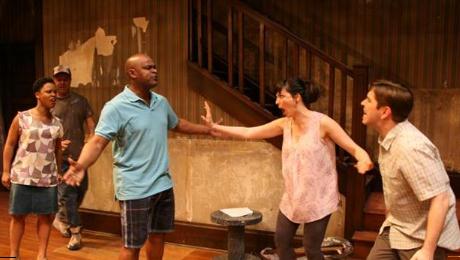The actors in Clybourne Park are all gifted and dedicated, but the real star is the script. Bruce Norris’s words are intricate, layered and, on occasion, laugh-out-loud funny.
Watching, and hearing, a stellar group of performers bite into such tasty writing is as satisfying as the theatrical experience itself. Clybourne Park‘s first act is set in 1959, and it takes a few minutes to adjust to the semi-realistic rhythms of the banter. Digressions, allusions and the revelation of family secrets lead to an explosion of — very 1950s — latent racism and sexism. It is very juicy, but it is a slow build, and the overlapping dialogue is a bit self-consciously structured and slows down the rhythm.
But it all pays off in the second act, which takes off like a rocket and just keeps building to a hilarious climax of political incorrectness. The digressions and allusions of the first act are echoed in very deft ways that, while obvious, are not offensive — it is a very, very clever script, and there were audible gasps as themes became clear or plot lines gelled into emotion.
It is easy to write a piece that indicts racism, sexism and, even for a fleeting, show-stopping comedic moment, homophobia; it is much harder to create an entertaining work that draws in playgoers and playfully forces them to confront their own ‘isms and phobias. Several of the biggest laughs in Clybourne Park occur when audience members suddenly recognize themselves in a moment of embarrassing but exquisitely funny shame. The vicious politically incorrect jokes induce both belly laughs and a quick intake of horror at what we have just admitted. It is a deliciously uneasy way to spend an evening.
All the cast members deserve special praise, as the script demands an ensemble to navigate the intricacy. To single out any one performance is impossible, as it would just be a list of extraordinary moments. Even a coda designed to tie it all together and send out the audience satiated manages to be evocative rather than maudlin.
Clybourne Park may thematically be about real estate and racism — a good fit for Toronto, with our market and neighbourhood problems — but it tries, and succeeds, to reveal some uncomfortable facets of the human condition.
(First published in Fab magazine).

 Why you can trust Xtra
Why you can trust Xtra


